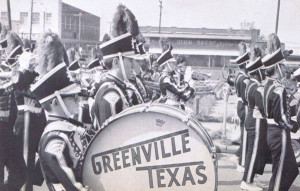Parades have been around since the days of Ancient Rome and Greece, perhaps even earlier. The earliest parades I have found in North Texas were circus parades, long before the coming of railroads. A circus parade was reported in Bonham shortly after the end of the Civil War. This particular one had a calliope bringing up the rear, followed by a lively crowd of children.
One of the most noted parades today is the Macy’s Thanksgiving Parade that unofficially begins the Christmas Season. This year the event celebrated its 90th anniversary, as did another Thanksgiving parade in Detroit. But Philadelphia has such a parade even older, one that began in 1920. However, the earliest Santa Claus Parade was held in Peoria, Illinois in 1887.
North Texans were just really settling in about that time. Santa Claus appeared at community Christmas Trees on Christmas Eve, but not in a parade.
I really believe that Christmas Parades around here originated in the mid to late 1920s.
Surprisingly, with the Great Depression came free or low cost entertainment such as movies, high school sports and bands. These entertainment venues became a means of temporarily forgetting about one’s troubles. Football fever infected every town with a high school, a fever that still rages throughout the region. Along with football came high school bands, twirlers, cheerleaders, and in some places girls’ drill teams.
During the Depression local stores in every county seat or the primary market center created elaborate scenes in their store windows during the Christmas season. While many families could not afford the items, simply looking at the Christmas wonders was enough. It was only natural that a Christmas Parade would follow. Prior to the end of World War II, the parades were held on Saturday afternoons when local farm and ranch families came to town to do their weekly shopping and enjoy some entertainment.
Parades usually began with flag bearers, marching or on horseback, carrying American and Texas flags. A grand marshal, some local person who had accomplished a significant feat, rode in a convertible from the local car dealer. Local bands and drill teams performed for the spectators. Homemade floats carried church groups, Girl Scouts, and older citizens around the parade route that always went by the courthouse. Boy Scouts and Cub Scouts marched along with pride. If the local football team had won at least a few games they rode on a flatbed trailer or marched by to the cheers of the crowd. Toward the end came the mounted riders decked out in their best blue jeans and shirts. If there was a mounted Sheriff’s Posse they rode in precision style on their best horses. Many wore matching shirts.
Finally at the end of the parade came the fire truck. Seated in a prominent place was the jolly old fellow himself, St. Nick. Like the children in Bonham after the Civil War, children in North Texas ran after the fire truck catching candy Santa tossed to them.
Little has changed in Christmas Parades. Antique cars seem to have replaced horses. But Santa still makes his appearance.

